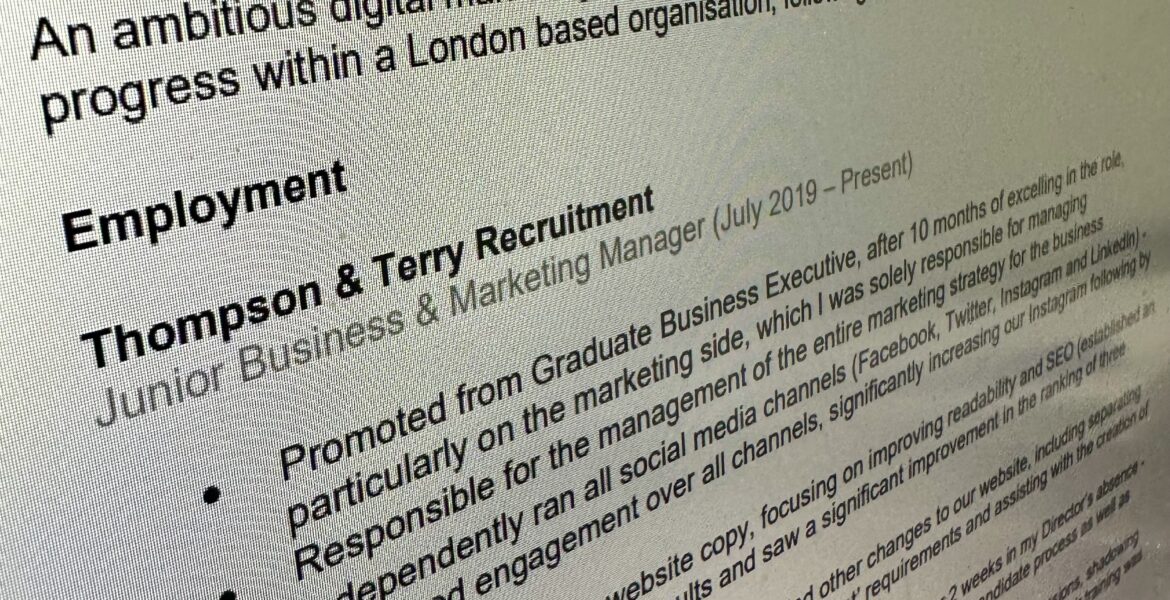How to Write a CV That’s Both AI and Human Friendly

One of the biggest frustrations I hear from candidates is:
“I keep applying for roles, but I’m not hearing anything back.”
More often than not, it’s not the candidate’s experience or ability holding them back: it’s their CV. In our modern world, it’s not just hiring managers that your CV must impress, it also needs to stand out to AI-powered recruitment systems that many companies now use to shortlist candidates, before a human even looks at your application.
The good news? Writing a CV that wows both AI and real people isn’t as complicated as it sounds. It does, however, mean that you need to be more intentional about how you write it.
Starting Strong: Your opening really counts – (Mainly for humans)
As cliché as it sounds, first impressions really do matter: especially when it comes to hiring managers. It is a slightly sad statistic; however, on average, recruiters spend as little as 3 seconds scanning a CV before deciding whether to read on. Therefore, the first couple of lines of your CV must quickly and clearly communicate who you are, what you’re looking for and why should they read on.
One trick to quickly get a human recruiter on your side is to make sure that your contact details (name, email, phone number, LinkedIn profile, and even just the first part of your postcode) are obviously visible, right at the top of your CV.
Then, add a short sentence underneath that summarises you; who you are, what you want and where. For example:
“An ambitious digital marketing graduate with 12 months experience seeking an opportunity to progress within a London based organisation, following a relocation from Oxfordshire.”
Even if that is the only sentence of your CV that a recruiter reads, they should still have a good sense of you, what you’re offering and whether to read on.
Your CV Doesn’t Need to Be One Page (Especially for AI and Technical Roles)
It is a common myth is that your CV must fit onto one (or at most two) pages. In reality, a longer CV is absolutely fine if it is; informative, relevant and well-organised.
In fact, for AI screening programs, a longer CV can be an advantage (only if relevant). More text means more opportunities to include the keywords that the AI is searching for. The software is scanning your CV for its relevance, not its length!
A longer CV can also appeal to a hiring manager once at the interview stage. When recruiting for more technical or specialised roles, hiring managers often want as much detail as possible to really get to grips with your experience and how it aligns with the role. If your CV is clearly laid out (and ALWAYS in bullet point format) and avoids repetition or filler, going over one/two pages will never harm your application and in some cases can even help it.
Take Key Words From Your Ideal Job Description
Before starting to write your CV – PAUSE – take a moment to look at the job descriptions for some of the roles you plan to apply for. This could be on a job board, a company careers page, or from a recruiter.
Highlight the exact wording in the job advert, especially the sections about the role’s key responsibilities, required skills, and any systems or software that it might mention. Then, tailor your CV to highlight these areas of your experience and, importantly for AI scanning, use the exact same wording in your CV that is in the job advert.
For example, if the job description mentions “report writing,” “CRM systems,” or “client onboarding,” and if you have experience of these things, make sure your CV uses those exact phrases (along with paraphrases if in context).
This is essential when writing for AI as many systems used in recruitment work by scanning CVs for specific keywords. If these words aren’t included, your application might not ever reach a real person.
Be Specific – An AI Reader Will Not Assume Anything
Unfortunately, many candidates tend to assume that a job title explains their entire role and assume everyone must know what an Office Manager does as an example. It is always better to spell out the details clearly.
Take telesales as an example. You might write something like, “Worked in a fast-paced sales role.” That might feel accurate, but it doesn’t really inform an AI or a recruiter about what you actually did.
Instead, a line like this is much more informative:
“Handled 50+ inbound and outbound calls daily to engage potential customers and follow up leads using HubSpot CRM.”
This version is much more detailed, includes useful keywords like “inbound and outbound calls,” and gives both human and AI a better picture of your actual day-to-day work involved.
Make It Relevant – Even If You Haven’t Done the Exact Role
If you’re applying for a role that is slightly different to what you’ve done before, do not be discouraged. You can absolutely still show that you are a strong candidate to both a real Recruiter and an AI!
One useful trick to highlight your relevant skills to a recruiter is to include a short section before your experience titled something along the lines of “Relevance to [Job Title]” and list quantifiable bullet points outlining how your experience matches each of criteria in order from the job description that you are applying for.
For example, say you’re applying for a PA role in the biotech industry but haven’t worked in that sector or as a PA before. You could use your “Relevance to [X Job Title] within [Company Name]” section to highlight your transferable skills. These could include things like: managing 4 diaries, producing X reports on Y, dealing with sensitive information, or even a personal interest in science (especially if you studied a STEM subject or have done any relevant learning on your own).
As long as your skills and experience relate to what’s in the job description (and you can honestly back them up) they absolutely belong in your CV.
Keep the Formatting Clean and Simple
The way your CV looks can make a massive difference, not just to the person reading it, but also to how well it can be scanned by an AI.
Overly creative layouts (with columns, graphics, icons, or unusual formatting) can confuse AI systems (and people!), causing them to ignore or misread critical information. While these designs can sometimes look impressive to the human eye, very often, they don’t translate at all well for automated screening software.
For this reason, we always recommend keeping your CV clear, clean, and simple. Ideally it should be presented in a Word document with standard section headings and no fancy formatting.
To further increase your CV’s accessibility to AI, stick to conventional labels like “Experience,” “Education,” “Skills,” and “Training.” It is also advisable to use a consistent font, clear bullet points, and spacing; avoid tables, images and text boxes unless absolutely necessary.
👉 If you would like to see an example of a CV following this formatting advice click HERE
A clean layout not only helps AI scan your CV correctly, it also makes it easier for a human to read too.
Should You Use AI Tools to Help Write Your CV?
This is a question I’ve been asked a lot recently. My colleague Ben actually wrote a great blog on it:
👉Should Candidates Use ChatGPT to Write Their CV? Click HERE
In short: AI can be a really helpful tool, especially if you’re struggling with structure, wording or key words. It’s also good for spotting keywords in job descriptions. However, your CV still needs to reflect your actual experience and most importantly be your own words (that means your words, not Ai or another human)
Think of AI as a supportive assistant, as helpful as it is, it cannot replace the human touch.
Final Thoughts: Write for Both the AI and the Recruiter
In today’s world, your CV has two audiences; AI and a human. It is essential that you write your CV to impress both.
This means that you need to ensure that you use the right keywords and write clearly, but balance this against keeping things personal and being totally transparent!
As always, if we can help in anyway whatsoever please do get in touch!



